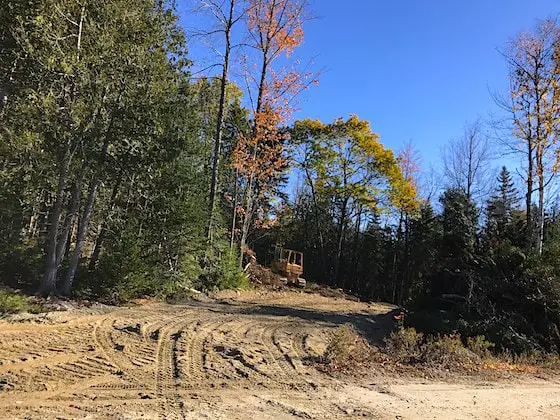Soil

This is the view looking from the road across the rough driveway cut. On the right side of the photo in the shade is a giant pile of slash - tree branches - that will be removed next week. Copyright 2018 Tim Carter
Geology and Soils
We interact with the Earth everyday. We really don't have much choice since we must move about on the face of this glorious planet. However, most of us pay little attention to the ground we walk or build upon. This can be a big mistake. The soil under your feet can change dramatically in type, quality, strength, fertility in as little as 500 feet.
Bedrock Geology & Soil
Soil in the simplest sense is a combination of small weathered pieces of rock, organic material, water, and air. The small pieces of rock determine, for the most part, the overall makeup of the soil.
For example, here in Cincinnati, we have 3 to 4 primary soil groups. These are directly related to the bedrock rock formations. Two of these formations and some of the glacial rock and soil material cause massive land slippage headaches around town. In fact, Cincinnati has the highest per capita damage per household in America due to landslides! I'll bet you didn't know that!
I was fortunate to learn all about this in college since I was a geology major. The trouble is, 99.95 percent of the home buyers in Cincinnati don't have a clue as to the dangerous soil conditions that face them everywhere.
You can almost always obtain free information about the soil conditions in your area from your county agricultural offices or building departments. Even counties that have lost all of their farmland to development have soil information. You simply have to make one or two phone calls to the county headquarters. Be persistent until you find the soil office.
Once you locate this division of your local government, ask for a county soil map. Usually these are books that are filled to the brim with useful information. The books often contain aerial photos which help you locate your street and often your house! The photos contain lines which create boundaries between the different soil types. The soil in a given zone has a symbol. You use this symbol throughout the book to find out all types of different positive and negative qualities about the soil.
For example, the actual description of the soil type tells you how thick the soil might be (in other words, how deep before you hit solid rock), color, depth to certain features within the soil such as perched watertables, etc. Deeper within the book, you get information pertaining to septic system suitability, strength of the soil for roadways and building, shrink/swell characteristics, and much more.
The best part is that this soil map/book is almost always free! Our tax dollars pay for it to be developed and distributed. Don't buy land without one!
Column B154